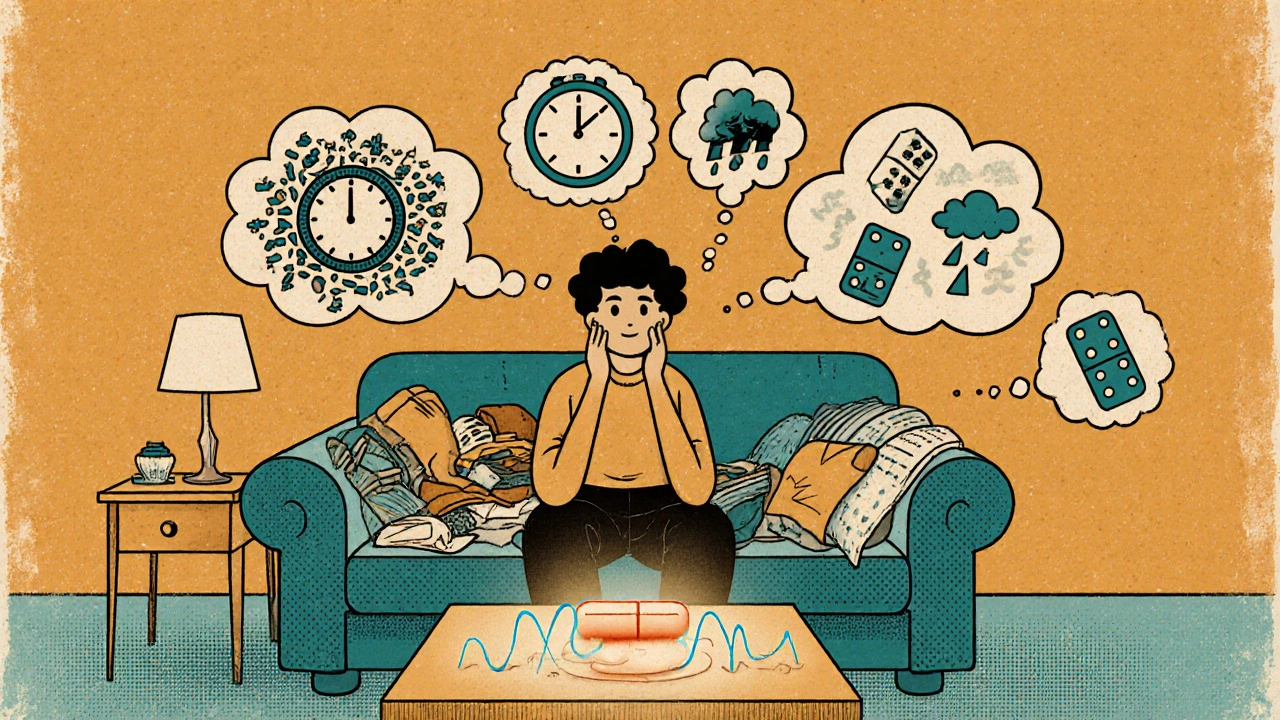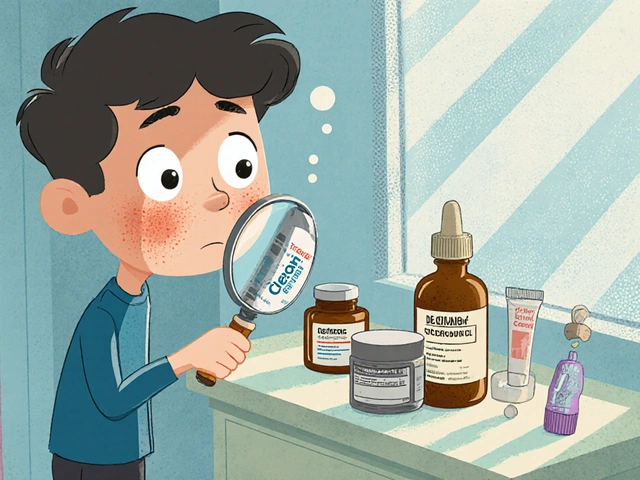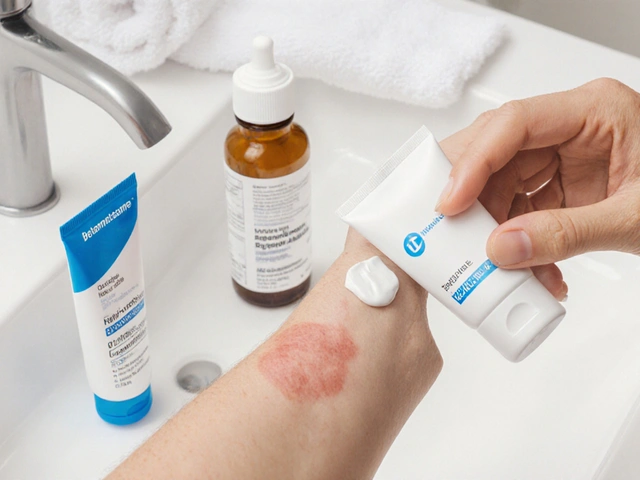Over 6 million Americans live with Generalized Anxiety Disorder (GAD) - a constant, overwhelming sense of worry that doesn’t fade, even when there’s no clear reason for it. People with GAD often feel on edge, tired, unable to concentrate, or tense in their muscles. It’s not just stress. It’s a persistent mental state that interferes with work, relationships, and sleep. And while it’s common, it’s also treatable. But choosing the right treatment isn’t simple. Three main options dominate the conversation: SSRIs, benzodiazepines, and Cognitive Behavioral Therapy (CBT). Each works differently, has different risks, and fits different lives.
What SSRIs Do for Anxiety
SSRIs - selective serotonin reuptake inhibitors - are the most commonly prescribed medications for GAD today. Drugs like escitalopram (Lexapro), sertraline (Zoloft), and paroxetine (Paxil) don’t calm you down right away. They take 2 to 6 weeks to start working. That’s because they don’t suppress symptoms like a sedative. Instead, they slowly adjust brain chemistry by increasing serotonin levels, helping the brain regulate fear and worry over time.Studies show about 50 to 60% of people with GAD respond well to SSRIs. That means their anxiety drops enough to function better. They’re especially helpful if you also have depression - which happens in about 60% of GAD cases. Unlike benzodiazepines, SSRIs don’t cause physical dependence. You can stop them safely, though withdrawal symptoms like dizziness or brain zaps can happen if you quit too fast.
Side effects are real. Nausea, especially in the first few weeks, is common. Sexual problems - like low libido or trouble reaching orgasm - affect nearly half of users. That’s why doctors often start with a low dose and slowly increase it. Many people quit SSRIs not because they don’t work, but because of these side effects. Still, long-term, they’re safer than alternatives. The VA/DoD guidelines call them first-line for a reason: they work, they’re tolerable, and they don’t lead to addiction.
The Fast Relief - and Hidden Risks - of Benzodiazepines
Benzodiazepines like alprazolam (Xanax), lorazepam (Ativan), and diazepam (Valium) work fast. Really fast. If you’re having a panic attack or can’t sleep because your mind won’t shut off, these drugs can calm you within 30 minutes. They boost GABA, the brain’s natural calming chemical, like flipping a switch.That speed made them the go-to treatment in the 1980s and 90s. But we now know the cost. About 40 to 50% of people who take benzodiazepines for more than 3 months develop tolerance. That means they need higher doses to get the same effect. Withdrawal can be brutal - worse than the original anxiety. Symptoms include rebound anxiety, insomnia, tremors, and even seizures in severe cases. The FDA added a boxed warning in 2020: these drugs carry risks of abuse, addiction, and dangerous withdrawal.
Despite the risks, they still have a place. For someone in crisis - say, a person with severe insomnia or acute panic attacks - a short 2-week course can be life-changing. But long-term use? The evidence says no. A 2024 meta-analysis found that while benzodiazepines work better than placebo in the short term, their effectiveness drops sharply after 6 months. Meanwhile, SSRIs and CBT keep working. That’s why guidelines from NICE, the APA, and the VA now say: avoid benzodiazepines as a first choice. Use them only when absolutely necessary, and never for more than a few weeks.
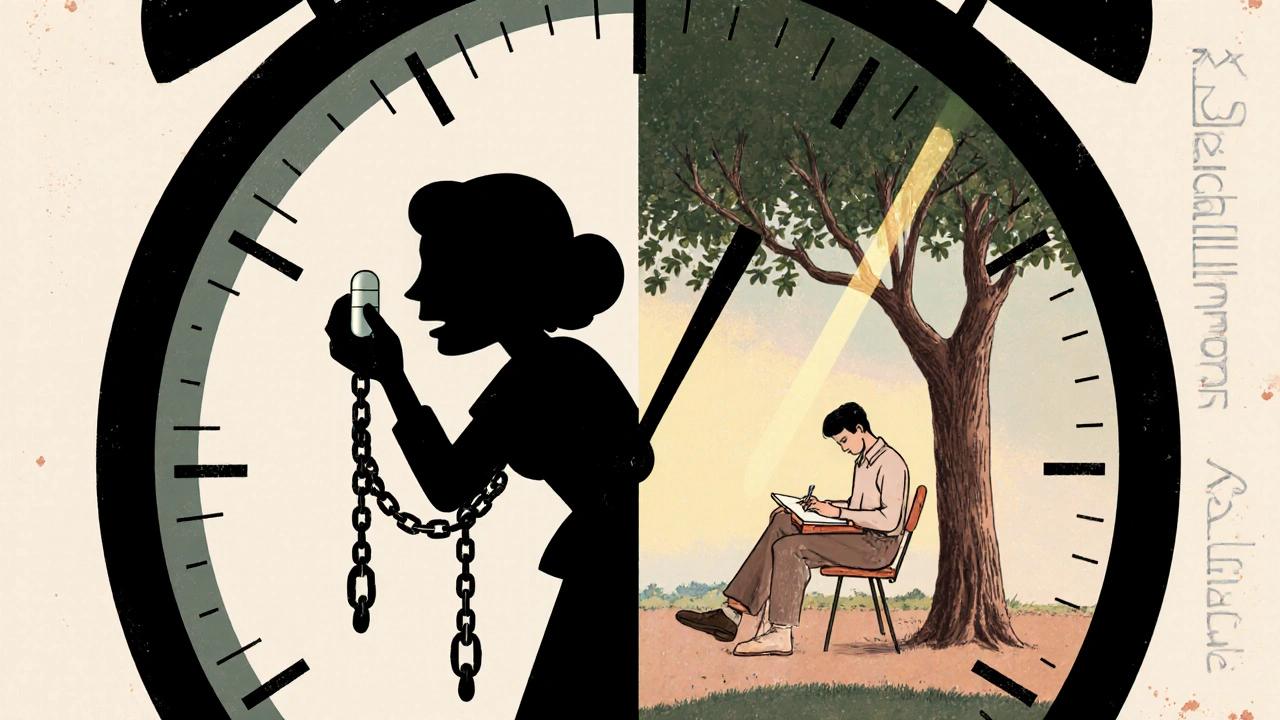
How CBT Changes the Way You Think - and Feel
Cognitive Behavioral Therapy doesn’t rely on pills. It’s a structured, time-limited form of talk therapy - usually 12 to 20 weekly sessions. The goal isn’t to make anxiety disappear. It’s to teach you how to handle it differently.CBT for GAD works in two main ways. First, it helps you catch and challenge catastrophic thoughts. If you think, “If I make a mistake at work, I’ll get fired and end up homeless,” CBT helps you test that thought. Is it true? What’s the evidence? What’s a more realistic outcome? Second, it uses exposure. You don’t avoid worry - you sit with it. You write down your worst fears and read them out loud. You delay reassurance-seeking. Over time, your brain learns that worry doesn’t lead to disaster.
Studies show CBT works as well as medication at the end of treatment. But here’s the kicker: it works better after you stop. A 2021 meta-analysis found that people who did CBT had a 25% relapse rate at 12 months. Those who stopped SSRIs? 45%. Why? Because CBT gives you tools. You don’t need a prescription to use them. You can apply them years later, even if anxiety comes back.
But CBT isn’t easy. It requires effort. You have to do homework - journaling, practicing new thoughts, facing fears. Only about 40% of people finish all sessions without support. And cost is a barrier. A single session can cost $100 to $150. Insurance often covers it, but finding a qualified therapist can take weeks. That’s why digital CBT apps like Woebot and SilverCloud are growing. They’re not a replacement, but they help bridge the gap.
Comparing the Three: What Works Best, When?
There’s no one-size-fits-all answer. But here’s how the three stack up based on real-world outcomes:
| Factor | SSRIs | Benzodiazepines | CBT |
|---|---|---|---|
| Speed of relief | 2-6 weeks | 30-60 minutes | 2-4 weeks (gradual) |
| Long-term effectiveness | High (sustained) | Low (tolerance builds) | Very high (skills last) |
| Dependence risk | None | High | None |
| Common side effects | Nausea, sexual dysfunction | Drowsiness, memory issues, dizziness | Initial discomfort during exposure |
| Relapse rate at 12 months | 45% | 60%+ (after stopping) | 25% |
| Best for | Chronic anxiety, comorbid depression | Acute crisis, short-term relief | Long-term skill building, relapse prevention |
For someone just starting treatment, most experts recommend SSRIs or CBT as the first step. If anxiety is crippling - say, you can’t leave the house - a short benzodiazepine course might help you get to a point where you can start therapy or take an SSRI. But that’s a bridge, not a destination.
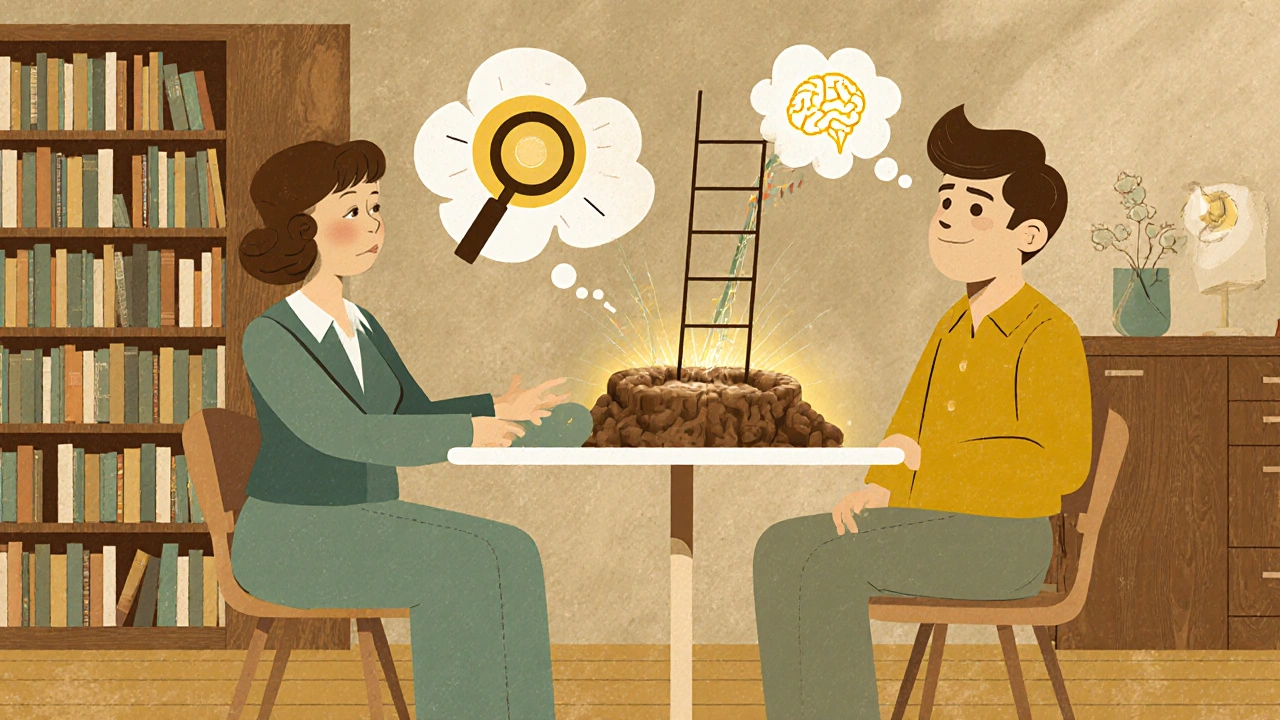
What Most People Actually Choose - And Why
Surveys show 78% of GAD patients prefer starting with SSRIs over benzodiazepines. Why? Fear of addiction. People hear stories on Reddit or Drugs.com about dependence and withdrawal, and they’re scared. Even though SSRIs have side effects, they feel safer.
But interest in CBT is high too - 65% of patients say they’d like to try it. The problem? Access. There are only about 0.5 licensed CBT therapists per 10,000 adults with anxiety in the U.S. Waiting lists are long. And not everyone can afford $1,500 for 12 sessions. That’s why digital tools are growing fast. Apps like Headspace and Calm aren’t CBT, but they teach mindfulness and breathing techniques that help. FDA-cleared apps like reSET offer actual CBT modules - and studies show they reduce symptoms by 37% in 12 weeks.
Insurance helps. Most plans cover SSRIs with a $10 copay. About 65% cover CBT, but with $30-$50 copays per session. Benzodiazepines? Only 40% of insurers cover them without prior authorization. That’s because they’re controlled substances. Doctors have to jump through hoops to prescribe them - and that’s by design.
The Future: Combining Treatments and New Options
The most effective approach isn’t choosing one - it’s combining them. A 2022 study in JAMA Network Open found that people who got both an SSRI and CBT had a 65% remission rate. That’s much higher than either alone.
New drugs are emerging too. Zuranolone, approved in 2023, works on GABA like benzodiazepines but has a much lower risk of dependence. In trials, only 5% had withdrawal symptoms, compared to 25% with traditional benzos. It’s not a magic bullet - it’s taken for two weeks - but it’s a promising option for acute episodes.
Genetic testing is also entering the picture. Companies like GeneSight analyze your DNA to predict how you’ll respond to SSRIs. If you’re a poor metabolizer of certain enzymes, your doctor can avoid drugs that might cause side effects. It’s not perfect - but it’s a step toward personalizing treatment.
The bottom line? GAD doesn’t have to control your life. You don’t need to suffer in silence. Whether you start with a pill, a therapist, or both, there’s a path forward. The key is choosing based on your goals: quick relief? Maybe a short-term benzo. Lasting change? CBT. Ongoing stability? SSRIs. And the best outcomes? Often, a mix of all three - used at the right time, in the right way.
Can I take SSRIs and benzodiazepines together?
Yes, but only under close medical supervision. Doctors sometimes prescribe a short course of benzodiazepines while waiting for an SSRI to kick in. But long-term use of both increases sedation, dizziness, and fall risk - especially in older adults. It’s not a standard approach and should be avoided unless absolutely necessary.
How long should I stay on an SSRI for GAD?
Most guidelines recommend staying on an SSRI for at least 6 to 12 months after symptoms improve. If you’ve had multiple episodes of anxiety, staying on it for 2 years or longer may reduce relapse. Never stop abruptly. Work with your doctor to taper slowly over weeks or months.
Is CBT better than medication for anxiety?
It’s not better - it’s different. CBT and SSRIs work equally well during treatment. But CBT has lower relapse rates after stopping. If you want skills you can use for life, CBT wins. If you need faster relief or struggle with therapy, medication may be more practical. Many people benefit from using both.
Can benzodiazepines be used long-term for GAD?
Most clinical guidelines say no. Long-term use leads to tolerance, dependence, and cognitive decline. Some doctors still prescribe them for years, especially in cases where other treatments failed. But the evidence shows the risks outweigh the benefits for chronic GAD. If you’ve been on them long-term, talk to your doctor about a slow taper - it’s possible, but it takes time and support.
What if I can’t afford CBT?
You don’t need in-person therapy to benefit from CBT. Apps like Woebot, Moodfit, and Sanvello offer CBT-based tools for free or low cost. Libraries and community mental health centers often provide sliding-scale therapy. Online directories like Psychology Today let you filter for therapists who accept insurance or offer reduced fees. Even reading a CBT workbook - like "The Anxiety and Phobia Workbook" - can help if you’re consistent.
